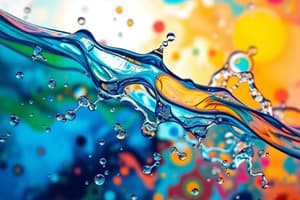Podcast
Questions and Answers
What is the primary reason freshwater organisms survive the winter?
What is the primary reason freshwater organisms survive the winter?
- Ice floats on liquid water. (correct)
- Solid water is denser than liquid water.
- Ice absorbs heat energy.
- Liquid water expands upon freezing.
Water molecules are covalently bonded together.
Water molecules are covalently bonded together.
True (A)
What is the optimal pH range for blood?
What is the optimal pH range for blood?
7.35 to 7.45
Water is a _____ fluid because it can dissolve polar and charged substances.
Water is a _____ fluid because it can dissolve polar and charged substances.
Match the following properties of water to their descriptions:
Match the following properties of water to their descriptions:
Which of the following is an example of a hydrophobic substance?
Which of the following is an example of a hydrophobic substance?
Hydrogen bonds are not significant in the properties of water.
Hydrogen bonds are not significant in the properties of water.
What type of molecule is formed from a carbon skeleton without any other atoms?
What type of molecule is formed from a carbon skeleton without any other atoms?
What are nonprotein molecules that assist enzyme catalysis called?
What are nonprotein molecules that assist enzyme catalysis called?
Enzymes are consumed during chemical reactions.
Enzymes are consumed during chemical reactions.
What process describes how DNA is copied into RNA?
What process describes how DNA is copied into RNA?
The primary energy currency of cells is ________.
The primary energy currency of cells is ________.
Match the type of RNA with its function:
Match the type of RNA with its function:
What structure describes the arrangement of DNA?
What structure describes the arrangement of DNA?
Substrates fit the active sites of enzymes through a 'lock and key' mechanism.
Substrates fit the active sites of enzymes through a 'lock and key' mechanism.
What are the monomers of nucleic acids called?
What are the monomers of nucleic acids called?
A change in the nucleotide sequence of DNA is called a ________.
A change in the nucleotide sequence of DNA is called a ________.
What is the role of proenzymes?
What is the role of proenzymes?
What are monosaccharides classified as?
What are monosaccharides classified as?
Glycogen is a linear chain of glucose monomers.
Glycogen is a linear chain of glucose monomers.
What type of bond forms between monosaccharides?
What type of bond forms between monosaccharides?
Lipids are __________ molecules made of carbon, hydrogen, and a small proportion of oxygen.
Lipids are __________ molecules made of carbon, hydrogen, and a small proportion of oxygen.
Which of the following is the main component of biological membranes?
Which of the following is the main component of biological membranes?
All fats are liquid at room temperature.
All fats are liquid at room temperature.
What is the primary role of triglycerides in the human body?
What is the primary role of triglycerides in the human body?
A protein's primary structure is the amino acid __________.
A protein's primary structure is the amino acid __________.
What type of proteins are round and water-soluble?
What type of proteins are round and water-soluble?
Denatured proteins retain their biological activity.
Denatured proteins retain their biological activity.
What are the four levels of protein structure?
What are the four levels of protein structure?
Match the lipid types with their characteristics:
Match the lipid types with their characteristics:
Eicosanoids are ________-carbon compounds.
Eicosanoids are ________-carbon compounds.
Which enzyme do humans lack to break down cellulose?
Which enzyme do humans lack to break down cellulose?
Flashcards are hidden until you start studying
Study Notes
Water Properties
- Water molecules exhibit cohesion due to hydrogen bonding, causing them to stick together.
- Water has a high specific heat capacity, meaning it can absorb a large amount of heat before its temperature increases significantly.
- Water releases heat back into the environment as it cools, moderating temperature fluctuations.
- Water expands upon freezing, making ice less dense than liquid water, allowing freshwater organisms to survive winter.
- Water is a polar molecule, making it an excellent solvent for polar and charged substances, which are considered hydrophilic.
- Hydrophobic substances, like oils and lipids, do not dissolve in water.
- Buffers help maintain a stable pH, preventing drastic fluctuations.
- Blood is predominantly water and must maintain a pH between 7.35-7.45.
Chemistry of Life
- All living matter is composed of molecules subject to chemical and physical laws.
- Organic molecules contain carbon.
- Hydrocarbons are molecules consisting solely of carbon and hydrogen.
- Functional groups are chemical groups attached to carbon skeletons that influence the properties of organic molecules.
- Different functional groups lead to different chemical properties, impacting the function of molecules within cells.
- Steroid hormones are modified structures based on cholesterol.
- Biological molecules are complex organic compounds composed of subunits called monomers.
- Polymers are long chains of monomers.
Carbohydrates
- Carbohydrates are composed of carbon, hydrogen, and oxygen.
- They constitute 2-3% of the body's mass.
- Monosaccharides are simple sugars that serve as monomers.
- Dehydration synthesis joins monosaccharides together, forming glycosidic linkages to create disaccharides and polysaccharides.
- Glycogen, a branched chain of glucose monomers, is the primary storage polysaccharide in animals.
- Starches, linear chains of glucose monomers, are the primary storage polysaccharides in plants.
- Humans lack the enzyme to break down cellulose.
Lipids
- Lipids are hydrophobic molecules made of carbon, hydrogen, and a small proportion of oxygen.
- They represent 18-25% of human body mass.
- Types of lipids include: fatty acids, triglycerides, phospholipids, steroids, eicosanoids, and fat-soluble vitamins.
- Fatty acids consist of a hydrocarbon chain with a carboxyl group at one end, and can be saturated or unsaturated.
- Triglycerides are three fatty acids bonded to a glycerol backbone.
- Fats are solid triglycerides at room temperature, while oils are liquid triglycerides.
- Triglycerides are stored in fat cells called adipocytes.
- Saturated fats are rich in saturated fatty acids.
- Unsaturated fats are either monounsaturated or polyunsaturated.
- Phospholipids have a glycerol backbone attached to two fatty acids and a phosphate group.
- They have a hydrophilic phosphate head and hydrophobic fatty acid tails, making them amphipathic.
- Steroids are formed from four fused carbon rings.
- Cholesterol is the precursor to other steroids and helps maintain membrane fluidity.
- Sterols are steroids with at least one hydroxyl group.
- Eicosanoids are 20-carbon compounds, including prostaglandins and leukotrienes, involved in immune signaling.
- Fat-soluble vitamins (D, E, and K)are essential for human health.
Proteins
- Proteins are made of carbon, hydrogen, oxygen, and nitrogen.
- They constitute 12-18% of human body mass.
- Proteins determine the structure of body tissues.
- Amino acids are the monomers of proteins.
- Amino acids have a central carbon atom bonded to an amino group, a carboxyl group, and a unique side chain (R group) that dictates its properties.
- Dehydration synthesis forms peptide bonds between amino acids.
- Many amino acids linked together form a polypeptide.
- The difference between a peptide and a protein is that a protein can be made of multiple polypeptide chains.
- Protein structure is essential for its function.
- The primary structure of a protein is the sequence of amino acids.
- The secondary structure of a protein results from repeated folds stabilized by hydrogen bonds.
- Tertiary structure describes the three-dimensional shape determined by primary and secondary structures, plus interactions between peptide chains.
- Quaternary structure refers to the arrangement of multiple polypeptide chains in a multi-peptide protein.
- Fibrous proteins form long parallel bundles and are water-insoluble, such as keratin and actin.
- Globular proteins are rounded and water-soluble, such as antibodies and enzymes.
- Denaturation is the loss of protein structure, causing a loss of function.
Enzymes
- Enzymes are biological catalysts that accelerate chemical reactions without being consumed.
- Enzymes use nonprotein molecules called cofactors to assist in catalysis.
- Organic cofactors are known as coenzymes.
- Chemical reactions would proceed too slowly or not at all without enzymes.
- Enzymes are specific, efficient, and regulated.
- Substrates bind to the active site of an enzyme, forming an enzyme-substrate complex.
- The enzyme catalyzes the reaction, then releases the products.
- Enzymes are highly specific, with substrates fitting into their active sites via a lock-and-key mechanism.
- Enzymes lower activation energy, the energy required to break bonds, making reactions proceed faster.
- Cells regulate enzyme production and activity.
- Proenzymes are inactive forms of enzymes that must be processed to become active.
Nucleic Acids
- Nucleic acids are made of carbon, hydrogen, oxygen, nitrogen, and phosphorus.
- They are made up of DNA and RNA.
- Genes are segments of DNA that provide instructions for protein synthesis.
- DNA is transcribed into RNA.
- RNA is translated by ribosomes to produce proteins.
- Nucleotides are the monomers of nucleic acids, containing a nitrogenous base, pentose sugar, and phosphate group.
- DNA contains the bases adenine (A), guanine (G), cytosine (C), and thymine (T).
- RNA contains A, G, C, and uracil (U).
- Bases pair together, with purines (A and G) pairing with pyrimidines (T and C).
- DNA's pentose sugar is deoxyribose, while RNA's is ribose.
- The phosphate groups and pentose sugars form the backbone of the nucleic acid molecule.
- DNA forms a double helix, with bases forming the "rungs" of the helix.
- DNA replication produces a new copy of the double helix using one strand as a template.
- A change in the DNA sequence is called a mutation.
- RNA is single-stranded and has three major types: mRNA, rRNA, and tRNA.
- Adenosine triphosphate (ATP) is a biologically-important nucleotide that serves as the energy currency of cells.
- It consists of adenosine (adenine plus ribose) with three phosphate groups.
- ATP is produced by exergonic reactions and consumed by endergonic reactions to power cellular work.
- Hydrolysis of the terminal phosphate group of ATP releases energy.
- ATP synthesis is catalyzed by ATP synthase during aerobic cellular respiration.
Summary
- Biological molecules are diverse organic molecules with specific functions.
- There are four classes: carbohydrates, lipids, proteins, and nucleic acids.
- Lipids are the only group that is not made of polymers of monomers.
- The structure of these molecules is closely linked to their specific function.
Studying That Suits You
Use AI to generate personalized quizzes and flashcards to suit your learning preferences.




